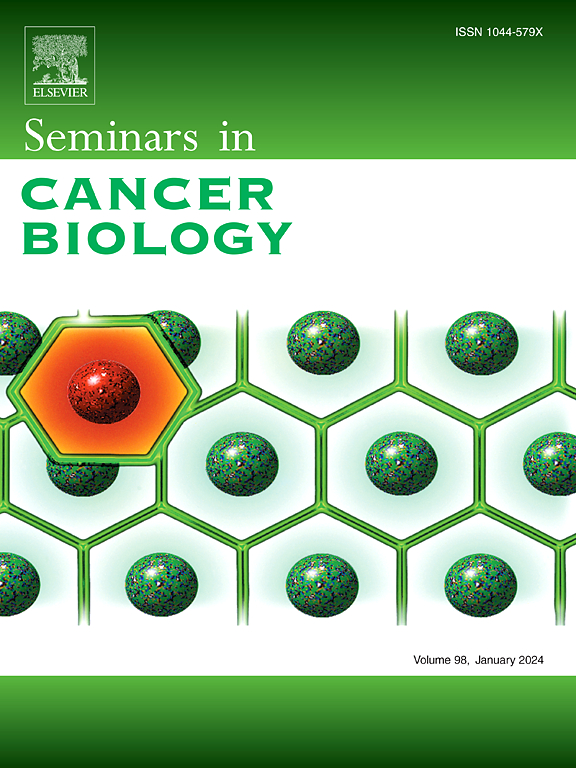胰腺神经内分泌肿瘤(pNENs):发生和预后风险的遗传和环境生物标志物
IF 12.1
1区 医学
Q1 ONCOLOGY
引用次数: 0
摘要
胰腺神经内分泌肿瘤(pNENs)是由神经内分泌细胞引起的罕见和异质性肿瘤,约占所有胃-肠-胰腺神经内分泌肿瘤的10% %。虽然大多数pNENs是散发的,但一个亚群与遗传综合征相关,如1型多发性内分泌瘤变(MEN1)或von Hippel-Lindau病(VHL)。pNENs进一步分为功能性和非功能性肿瘤,具有不同的临床行为、预后和治疗方法。这篇综述探讨了影响pNENs风险、预后和治疗反应的遗传和环境生物标志物。pNENs的流行病学显示其发病率不断上升,这主要是由于成像技术的进步。遗传因素起着关键作用,MEN1、VHL和其他基因的种系突变会导致家族性pNENs。体细胞突变,包括mTOR通路和DNA维持基因(如DAXX和ATRX)的改变,是散发性pNENs的关键。这些突变,以及表观遗传失调和转录组改变,巩固了pNENs不同的临床和分子表型。新出现的证据表明,表观遗传变化,包括DNA甲基化谱,可以对pNEN亚型进行分层并预测疾病进展。环境和生活方式因素,如糖尿病、吸烟和慢性胰腺炎,与散发性pNENs的风险增加有关。虽然这些因素与肿瘤进展之间的关系仍在调查中,但它们在影响治疗结果方面的潜在作用值得进一步研究。全身治疗的进展,包括生长抑素类似物、mTOR抑制剂和酪氨酸激酶抑制剂,改善了疾病的管理。Ki-67、生长抑素受体表达和o6 -甲基鸟嘌呤- dna甲基转移酶(MGMT)状态等生物标志物正在被评估其预测价值。新方法,包括使用循环生物标志物(NETest、循环肿瘤细胞和ctDNA)和多基因风险评分,为非侵入性诊断和监测提供了有希望的途径。尽管取得了这些进步,但挑战依然存在,包括对大型、注释良好的数据集和经过验证的生物标志物的需求。未来的研究应整合多组学方法,并利用液体活检技术来完善诊断、预后和治疗策略。跨学科合作和全球联盟对于克服当前的局限性和将研究成果转化为临床实践至关重要。这些见解有望改善预防、早期发现和量身定制的治疗,最终提高患者的治疗效果。本文章由计算机程序翻译,如有差异,请以英文原文为准。
Pancreatic neuroendocrine neoplasms (pNENs): Genetic and environmental biomarkers for risk of occurrence and prognosis
Pancreatic neuroendocrine neoplasms (pNENs) are rare and heterogeneous tumors arising from neuroendocrine cells, representing approximately 10 % of all Gastro-Entero-Pancreatic neuroendocrine neoplasms. While most pNENs are sporadic, a subset is associated with genetic syndromes such as multiple endocrine neoplasia type 1 (MEN1) or von Hippel-Lindau disease (VHL). pNENs are further classified into functioning and non-functioning tumors, with distinct clinical behaviors, prognoses, and treatment approaches. This review explores genetic and environmental biomarkers that influence the risk, prognosis, and therapeutic responses in pNENs. The epidemiology of pNENs reveals an increasing incidence, primarily due to advancements in imaging techniques. Genetic factors play a pivotal role, with germline mutations in MEN1, VHL, and other genes contributing to familial pNENs. Somatic mutations, including alterations in the mTOR pathway and DNA maintenance genes such as DAXX and ATRX, are critical in sporadic pNENs. These mutations, along with epigenetic dysregulation and transcriptomic alterations, underpin the diverse clinical and molecular phenotypes of pNENs. Emerging evidence suggests that epigenetic changes, including DNA methylation profiles, can stratify pNEN subtypes and predict disease progression. Environmental and lifestyle factors, such as diabetes, smoking, and chronic pancreatitis, have been linked to an increased risk of sporadic pNENs. While the association between these factors and tumor progression is still under investigation, their potential role in influencing therapeutic outcomes warrants further study. Advances in systemic therapies, including somatostatin analogs, mTOR inhibitors, and tyrosine kinase inhibitors, have improved disease management. Biomarkers such as Ki-67, somatostatin receptor expression, and O6-methylguanine-DNA methyltransferase (MGMT) status are being evaluated for their predictive value. Novel approaches, including the use of circulating biomarkers (NETest, circulating tumor cells, and ctDNA) and polygenic risk scores, offer promising avenues for non-invasive diagnosis and monitoring. Despite these advancements, challenges remain, including the need for large, well-annotated datasets and validated biomarkers. Future research should integrate multi-omics approaches and leverage liquid biopsy technologies to refine diagnostic, prognostic, and therapeutic strategies. Interdisciplinary collaborations and global consortia are crucial for overcoming current limitations and translating research findings into clinical practice. These insights hold promise for improving prevention, early detection, and tailored treatments, ultimately enhancing patient outcomes.
求助全文
通过发布文献求助,成功后即可免费获取论文全文。
去求助
来源期刊

Seminars in cancer biology
医学-肿瘤学
CiteScore
26.80
自引率
4.10%
发文量
347
审稿时长
15.1 weeks
期刊介绍:
Seminars in Cancer Biology (YSCBI) is a specialized review journal that focuses on the field of molecular oncology. Its primary objective is to keep scientists up-to-date with the latest developments in this field.
The journal adopts a thematic approach, dedicating each issue to an important topic of interest to cancer biologists. These topics cover a range of research areas, including the underlying genetic and molecular causes of cellular transformation and cancer, as well as the molecular basis of potential therapies.
To ensure the highest quality and expertise, every issue is supervised by a guest editor or editors who are internationally recognized experts in the respective field. Each issue features approximately eight to twelve authoritative invited reviews that cover various aspects of the chosen subject area.
The ultimate goal of each issue of YSCBI is to offer a cohesive, easily comprehensible, and engaging overview of the selected topic. The journal strives to provide scientists with a coordinated and lively examination of the latest developments in the field of molecular oncology.
 求助内容:
求助内容: 应助结果提醒方式:
应助结果提醒方式:


